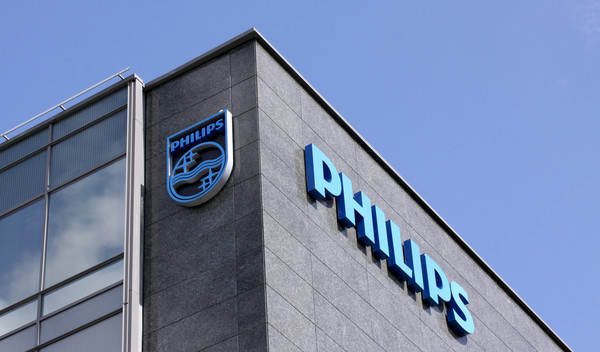Job cuts announced as the sales slump
Philips has racked up its sixth recall related to its continuous positive airway pressure (CPAP) device from the U.S. Food and Drug Administration (FDA) on Oct. 19.

The company first began a recall of around 5.5 million devices used by sleep apnea patients , including bi-level positive airway pressure (BiPAP), CPAP, and mechanical ventilator devices, after the FDA identified potential health risks related to the polyester-based polyurethane (PE-PUR) sound abatement foam component used in the devices in June of last year.
However, the company has continued to uncover a handful of other safety issues within its respiratory device portfolio since.
The most recent recall involves a problem with the magnetic clips and straps found in some masks. They are used with its CPAP and BiPAP machines that may interact with certain implanted medical devices in both the wearers of the masks and other people who come in close proximity to them.
Philips Korea was unavailable for immediate comments regarding how many products in Korea will be affected by the recent recall.
However, industry watchers expect that the number will not be large, given the small market share of the company’s devices in Korea.
During the initial global recall of 5.5 million products, only 24,400 deivces were subject to recall in Korea.
“We expect to recall approximately 24,400 CPAP and BiPAP devices regarding the initial recall,” a company official had said to Korea Biomedical Review.” Philips Respironics has already shipped more than 21,000 repair kits to Korea.”
Philips Korea is conducting the recall process following relevant laws and regulations and guidelines from the Ministry of Food and Drug Safety, she added.
Regarding the recall process, the official stated that the PE-PUR sound abatement foam, which was the reason for the initial recall, had been replaced with a new medical-grade silicone part.
“Philips Korea is performing replacement and repair services for the airpath assembly, including the motor and the blower box that contains the silicone sound abatement foam,” the official said. “In addition, Philips Korea attaches a test certificate sticker after device sterilization, cleansing, and performance inspection and delivers the CPAP device to the user.”
The company said it was trying to complete the recall as soon as possible, but some devices have not yet been recalled due to reasons such as long-term business trips, personal circumstances, no longer use of the device, and loss of contacts.
“Philips Korea is fully cooperating with distributors to keep in touch with patients and provide the necessary support,” she said.
Despite the company’s efforts, the continuous safety issue of the company’s respiratory products has raised concerns among Korean sleep apnea patients and suppliers about the reliability of Philips’ products.
Korean patients have complained about too many recalls.
“I am flabbergasted that such a large global company could not predict that a magnet could affect other medical devices,” a patient wrote on a Korean website for CPAP users. “This shows that products from large companies such as Philips cannot always be trusted.”
Another patient expressed anger that he had not received any instructions on the recall process after receiving the initial notification and asked other Philips CPAP users how to proceed.
CPAP rental shops are also slowly turning their backs on Philip’s products.
“Because of the strong brand power of Philips, many people have been using Philip’s CPAP device,” a CPAP rental shop owner said. “However, with the company hit with numerous recalls over the past year and the recall still continuing, complaints from our customers are growing.”
As there are recently many products that are superior in convenience, the shop is recommending customers to try new CPAP devices, he added.
Meanwhile, the recall has also greatly affected Philips’ earnings. At the beginning of this year, the company had estimated that the safety event had slashed its net income for all of 2021 by about 719 million euros.
Backed by the slump in sales, the company changed its top management position. Frans van Houten, who had held the top job at Philips since 2011, stepped down and the company named Roy Jakobs the new CEO on Oct.15.
Taking office as CEO, Jakobs apologized for the pain caused by the recent fiasco involving the recalls of the company’s CPAP device.
“The product recall of our Respironics sleep apnea devices let down the many patients who relied on them, as well as the doctors and nurses caring for those patients, for which I am deeply sorry,” Jakobs said. “While I can point to many great ways Philips is helping to improve people’s health and well-being, any quality issue across the company hurts.”
Despite the new leadership, the financial fiasco has continued in the months since, as the company issued a warning last week that its upcoming third-quarter results will show a year-over-year decrease in its connected care sales and a 5 percent drop in its overall sales.
As a result, Jakobs said that the company plans to cut 4,000 jobs as sales slip during an investor call on Monday.
“We’re taking immediate steps to reduce the costs involved in running the company,” said Jakobs. “This includes the difficult but necessary decision to immediately reduce our workforce by around 4,000 roles globally, subject to consultation with the .relevant workers’ councils and social partners.”
This is a decision that the company does not take lightly and which it will implement with respect towards impacted colleagues, but one that is needed to cope with the current challenges, Jakobs added.
Philip Korea was unavailable for immediate comments regarding if the job cuts announced by headquarters would affect the offshoot.
According to a job site, the Korean offshoot of the company currently has 341 employees.
Related articles
- Sleep society issues guideline on Philips’s recalled positive pressure respirators
- Philips to recall some sleep and respiratory care devices
- ‘Paradigm shift critical to transform neglected gum diseases’
- Novartis Korea ordered to recall water for injection for immunosuppressant due to possible glass particle contamination

